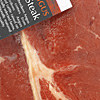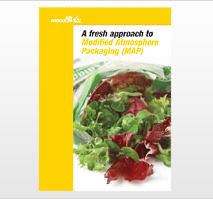Raw Red Meat

Food items: Beef, Goat, Hare, Horse, Lamb, Pork, Rabbit, Veal, Venison, Wild Boar, other items
Recommended gas mix
The gases and mixtures listed above are for general guidance. To identify the optimum gas for your product and process, we recommend you undertake a product trial, with the help of an Air Products MAP gas specialist. If you would like a specialist to contact you to discuss this more click here. Storage temperature Achievable shelf-life |
Principle spoilage organisms and mechanics Food poisoning hazards include Typical MAP machines Typical types of package Examples of typical MAP materials Lidding and/or pillow pack film: Bulk and primal |
||||||||||||||||||||||||||||||||
 The
two principal spoilage mechanisms affecting the shelf-life
of raw red meats are microbial growth and oxidation of
the red oxymyoglobin pigment.
The
two principal spoilage mechanisms affecting the shelf-life
of raw red meats are microbial growth and oxidation of
the red oxymyoglobin pigment.
When red meat is kept under proper chilled conditions, the controlling influence on the shelflife of the product is the rate of oxidation of the red oxymyoglobin pigment to its brown oxidised form, metmyoglobin. For this reason, high concentrations of O2 are necessary for the MAP of red meats in order to maintain the desirable bright red colour for a longer period. Highly pigmented red meats, such as venison and wild boar, require higher concentrations of O2.
Aerobic spoilage bacteria, such as Pseudomonas species, which are normally predominant on red meats are inhibited by CO2. Consequently, to create the dual effect of red colour stability and microbial inhibition, gas mixtures containing 20-30% CO2 and 70-80% O2 are recommended for extending the chilled shelf-life of red meats from 2-4 days to 5-8 days and even longer. A gas/product ratio of 2:1 is often recommended. The maintenance of recommended chilled temperatures and good hygiene and handling throughout the butchery, MAP, distribution and retailing chain is also of vital importance in ensuring the safety and extended shelf-life of red meat products.
Red meats provide an ideal medium for the growth of a wide range of spoilage and food poisoning micro-organisms. It should be noted that raw red meats are subsequently cooked before consumption and thorough heating is sufficient to kill the vegetative cells of food poisoning bacteria. Consequently, the risk of food poisoning is greatly minimised by proper cooking.







